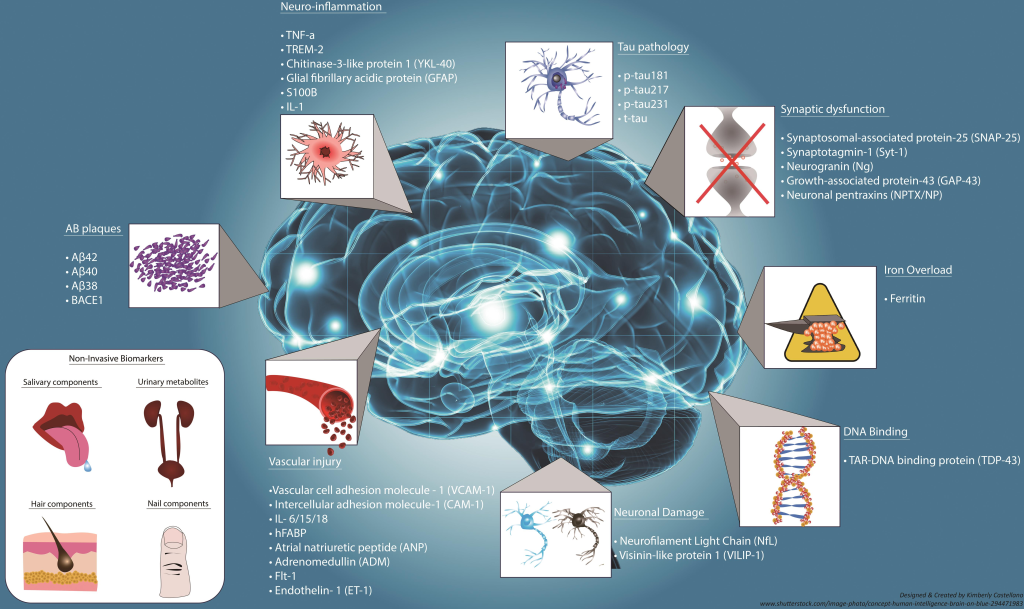Alzheimer’s disease research is at the forefront of modern neuroscience, aiming to unlock the mysteries of this debilitating condition that affects millions worldwide. A groundbreaking study led by Dr. Lulu Jiang is shedding light on how subtle alterations in RNA and the Tau protein contribute to the disease’s progression. Utilizing innovative 3D brain models, her team is diving deep into understanding the complex interactions at play in the human brain. This research not only holds promise for developing more effective treatments but also paves the way for future advancements in Alzheimer’s care. By exploring these intricate molecular mechanisms, Dr. Jiang and her colleagues are striving to transform scientific insights into real-world applications that could significantly improve the lives of those affected by Alzheimer’s.
Exploring the intricacies of dementia, particularly Alzheimer’s disease, is essential for developing effective therapeutic strategies. Dr. Lulu Jiang, a prominent figure in this field, is spearheading research that investigates the role of molecular components such as RNA and Tau protein in the onset and progression of cognitive decline. Through the use of advanced 3D brain models, her team seeks to unravel the connections between genetic factors and neurodegenerative processes. This research not only enhances our understanding of Alzheimer’s but also provides crucial insights that could lead to innovative treatments. As we delve into the biological underpinnings of this condition, the hope is to create a roadmap toward better patient outcomes and inspire future generations of scientists.
Dr. Lulu Jiang: A Pioneer in Alzheimer’s Disease Research
Dr. Lulu Jiang is making significant strides in the realm of Alzheimer’s disease research, employing cutting-edge techniques to unravel the complexities of this condition. As an Assistant Professor at the UVA School of Medicine, she leads a dedicated team focused on understanding the intricate relationships between RNA alterations and the detrimental effects of Tau protein in the brain. Her innovative approach includes utilizing advanced 3D brain models, which provide a unique perspective on how cellular changes contribute to Alzheimer’s progression.
With a keen focus on the molecular mechanisms that underlie Alzheimer’s disease, Dr. Jiang’s research aims to bridge the gap between laboratory findings and clinical applications. By investigating how modifications in RNA can influence brain cell function, her work is pivotal in identifying potential therapeutic targets. Her commitment to advancing this field not only sheds light on the disease’s pathology but also inspires the next generation of scientists to explore groundbreaking solutions.
Understanding the Role of Tau Protein in Alzheimer’s Progression
Tau protein has long been recognized as a central player in the pathology of Alzheimer’s disease. In a healthy brain, Tau stabilizes the structure of neurons; however, its misfolding leads to the formation of neurofibrillary tangles, which disrupt neuronal communication. Dr. Jiang’s research emphasizes the importance of studying these tau aggregates to better understand their role in cognitive decline. By utilizing advanced 3D brain models, her team can simulate the environment of the human brain, providing deeper insights into how Tau protein dysfunction contributes to the disease.
In addition to examining Tau protein, Dr. Jiang’s work also highlights the significance of RNA alterations in Alzheimer’s pathology. These RNA changes can affect gene expression and protein synthesis, ultimately influencing neuronal health. By correlating the presence of Tau tangles with RNA modifications, the research aims to unravel the complex interactions that lead to neurodegeneration. The findings from this research could pave the way for novel therapeutic strategies that target both Tau protein and RNA pathways, offering hope for more effective treatments.
The Impact of RNA Alterations on Brain Health
Ribonucleic acid (RNA) plays a critical role in the functioning of cells, particularly in the brain, where it is responsible for translating genetic information into proteins that are essential for neuronal health. In the context of Alzheimer’s disease, abnormalities in RNA can lead to impaired protein production and contribute to the degeneration of brain cells. Dr. Lulu Jiang’s research focuses on identifying specific RNA alterations that may exacerbate the effects of Tau protein tangles, thereby advancing our understanding of the disease process.
By examining patient tissue samples, Dr. Jiang and her team are working to uncover the intricate relationship between RNA modifications and the onset of Alzheimer’s symptoms. Their research aims to elucidate how these tiny changes at the molecular level can manifest in significant cognitive decline over time. Understanding these dynamics is crucial for developing targeted interventions that could mitigate RNA-related damage and support brain health in individuals at risk for Alzheimer’s.
Teamwork in Neuroscience: Collaborative Approaches to Alzheimer’s Research
The complexity of Alzheimer’s disease necessitates a collaborative approach to research, as highlighted by Dr. Lulu Jiang’s ongoing projects. Her team comprises experts in various fields of neuroscience, working together to tackle the multifaceted challenges posed by this condition. By pooling their knowledge and skills, they can conduct experiments that delve deeper into the disease’s mechanisms, exploring everything from Tau protein dynamics to RNA alterations.
Dr. Jiang emphasizes that teamwork is essential for the success of their research endeavors. Each team member brings a unique perspective, allowing for innovative solutions to emerge. This collaborative spirit not only enhances the quality of their findings but also fosters an environment where emerging scientists can thrive and contribute to significant advancements in Alzheimer’s research. Together, they are paving the way for new discoveries that could ultimately lead to better treatments for those affected by this devastating disease.
Innovations in 3D Brain Models for Alzheimer’s Research
Advancements in technology have revolutionized the way researchers study Alzheimer’s disease, with 3D brain models emerging as a particularly powerful tool. Dr. Lulu Jiang’s use of these models allows her team to simulate the human brain’s environment more accurately than traditional methods, facilitating a deeper understanding of the disease’s progression. These innovative models enable researchers to observe how Tau protein and RNA alterations interact in real-time, providing invaluable insights into their roles in neurodegeneration.
By integrating 3D brain models into their research, Dr. Jiang’s team can conduct experiments that replicate the complexities of human brain tissue. This approach not only enhances the reliability of their findings but also opens up new avenues for testing potential therapies. As they explore the molecular mechanisms of Alzheimer’s disease, the insights gained from these models could lead to groundbreaking treatments that target the underlying causes of the condition.
Funding and Support for Alzheimer’s Disease Research
Research into Alzheimer’s disease requires substantial resources, and Dr. Lulu Jiang’s work is bolstered by a generous five-year grant from the National Institutes of Health. This funding is crucial for advancing their studies on the molecular underpinnings of the disease, allowing for the expansion of their research capabilities. With this support, Dr. Jiang and her team can enhance their technological approaches, including the use of 3D brain models and advanced genetic analysis techniques.
The backing from such prestigious institutions not only affirms the importance of their research but also ensures that scientists like Dr. Jiang can continue to investigate promising avenues that have the potential to transform patient care. As they delve deeper into the complexities of Alzheimer’s disease, this financial support enables them to make strides toward developing innovative treatments that could improve the lives of countless individuals affected by this condition.
The Future of Alzheimer’s Disease Treatment: Hope and Innovation
As research continues to evolve, there is a growing sense of optimism regarding the future of Alzheimer’s disease treatment. Dr. Lulu Jiang and her team are at the forefront of this movement, exploring new methodologies that target the disease’s root causes. By focusing on the interplay between Tau protein and RNA alterations, their research may unveil novel therapeutic approaches that could halt or even reverse the cognitive decline associated with Alzheimer’s.
The commitment to innovation in Alzheimer’s research is paramount, and Dr. Jiang’s dedication to mentoring the next generation of scientists ensures that this field will continue to advance. By fostering a culture of collaboration and creativity, her team is set to contribute significantly to the understanding and potential treatment of Alzheimer’s disease. As new discoveries emerge, there is hope that effective therapies will soon be available, transforming the landscape of care for patients and families affected by this challenging condition.
Empowering Future Scientists in Neuroscience
Dr. Lulu Jiang is not only focused on advancing Alzheimer’s disease research but also on empowering the next generation of scientists. She recognizes the importance of nurturing young talent in neuroscience, as they will be the ones to carry forward the critical work needed to combat neurodegenerative diseases. By providing mentorship and hands-on research opportunities, Dr. Jiang aims to inspire a passion for science in her students, encouraging them to explore innovative solutions to pressing health challenges.
The importance of training future scientists cannot be overstated, especially in fields as complex as neuroscience. Dr. Jiang’s commitment to education is evident in her collaborative approach, where she actively involves students in her research projects. By integrating them into the research process, she not only enhances their learning experience but also prepares them to tackle the challenges that lie ahead in Alzheimer’s disease research and treatment.
The Global Perspective on Alzheimer’s Disease Research
Alzheimer’s disease is a global health concern, and research efforts are being undertaken worldwide to address this pressing issue. Dr. Lulu Jiang’s work at the UVA School of Medicine contributes to a broader understanding of the disease’s mechanisms and potential treatments. By collaborating with researchers across the globe, her team is part of a collective effort to share insights and develop more effective strategies to combat Alzheimer’s.
The Alzheimer’s Association plays a crucial role in promoting international research initiatives, providing a platform for scientists to connect and share findings. Dr. Jiang encourages those interested in the field to explore these global resources, as they offer valuable information on ongoing research efforts and emerging treatments. The collaborative nature of Alzheimer’s research holds great promise for breakthroughs that could benefit millions of individuals and families affected by the disease.
Frequently Asked Questions
What is Dr. Lulu Jiang’s role in Alzheimer’s disease research?
Dr. Lulu Jiang is a leading researcher in Alzheimer’s disease research, focusing on the molecular mechanisms of the disease. As an Assistant Professor at the UVA School of Medicine, she employs advanced techniques like 3D brain models to study how RNA alterations and Tau protein tangles affect brain cell communication and contribute to Alzheimer’s progression.
How do 3D brain models contribute to Alzheimer’s disease research?
3D brain models are crucial in Alzheimer’s disease research as they provide a more accurate representation of human brain tissue. Dr. Lulu Jiang and her team use these models to investigate the impact of Tau protein clumping and RNA alterations on brain cell function, aiming to discover new treatment strategies.
What role does Tau protein play in Alzheimer’s disease?
Tau protein is vital for maintaining the structure and function of brain cells. In Alzheimer’s disease, Tau protein can form tangled clumps, disrupting communication between cells and contributing to cognitive decline. Research led by Dr. Lulu Jiang explores the mechanisms behind Tau protein alterations and their implications for Alzheimer’s progression.
How do RNA alterations affect Alzheimer’s disease pathology?
RNA alterations are significant in Alzheimer’s disease pathology as they can influence how brain cells degrade. Dr. Lulu Jiang’s research investigates the small changes in RNA that may lead to abnormal cell function and contribute to the development of Alzheimer’s, aiming for deeper insights into the disease’s progression.
What advancements are being made in Alzheimer’s disease research at UVA?
At the University of Virginia, advancements in Alzheimer’s disease research are being led by Dr. Lulu Jiang, who utilizes innovative technologies and 3D brain models. Supported by a five-year NIH grant, her team is focused on understanding the molecular mechanisms involved in Alzheimer’s, including the roles of Tau protein and RNA alterations.
How can research in Alzheimer’s disease impact future treatments?
Research in Alzheimer’s disease, particularly studies conducted by experts like Dr. Lulu Jiang, aims to uncover the underlying mechanisms of the disease. By understanding how Tau protein tangles and RNA alterations affect brain function, this research could lead to the development of more effective treatments and improve patient care in the future.
What is the significance of the National Institutes of Health grant for Alzheimer’s research?
The National Institutes of Health grant is significant for Alzheimer’s research as it provides essential funding for innovative studies. Dr. Lulu Jiang’s team at UVA will use this support to expand their research on Tau protein and RNA alterations, potentially leading to breakthroughs in understanding and treating Alzheimer’s disease.
What are the long-term goals of Dr. Lulu Jiang’s Alzheimer’s research team?
The long-term goals of Dr. Lulu Jiang’s Alzheimer’s research team include translating their findings into practical applications for patient care, improving our understanding of the disease’s mechanisms, and fostering the next generation of scientists committed to advancing Alzheimer’s disease research.
| Key Points | Details |
|---|---|
| Research Focus | Investigating tiny changes in brain instructions related to Alzheimer’s disease. |
| Lead Researcher | Dr. Lulu Jiang, Assistant Professor at UVA School of Medicine. |
| Research Methodology | Utilization of advanced 3D brain models and mouse models. |
| Key Biomolecules | RNA and Tau protein are implicated in the progression of Alzheimer’s disease. |
| Research Objectives | To understand molecular mechanisms of Alzheimer’s disease and how it evolves. |
| Funding | Supported by a five-year grant from the National Institutes of Health. |
| Future Aspirations | To assist the next generation of scientists in Alzheimer’s research. |
Summary
Alzheimer’s disease research is at a pivotal moment, with new studies like Dr. Lulu Jiang’s offering hope for better treatments. This innovative research utilizes advanced models to uncover the intricate mechanisms behind the disease, focusing on critical biomolecules such as RNA and Tau protein. As the team seeks to understand how Alzheimer’s progresses, their work not only promises to enhance patient care but also to inspire future generations of scientists. With robust support from national institutions, this research stands as a beacon of hope in the fight against Alzheimer’s.
The content provided on this blog (e.g., symptom descriptions, health tips, or general advice) is for informational purposes only and is not a substitute for professional medical advice, diagnosis, or treatment. Always seek the guidance of your physician or other qualified healthcare provider with any questions you may have regarding a medical condition. Never disregard professional medical advice or delay seeking it because of something you have read on this website. If you believe you may have a medical emergency, call your doctor or emergency services immediately. Reliance on any information provided by this blog is solely at your own risk.








